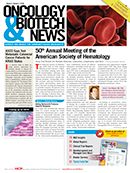Publication
Article
OBTN
Flash Findings
Author(s):
Fast biotech facts and figures. In this issue: 1) Cancer Risk Factors and Mortality 2) Bladder Cancer 3) Testicular Cancer 4) Breast Cancer
Click here to view as PDF.
â–º FLASHFINDINGS:
Fast Facts from the Front Lines
Cancer Risk Factors and Mortality
• Environmental factors such as infectious
agents, poor nutrition, tobacco use, occupational
exposure to carcinogens, and
exposure to sunlight or pollutants account
for 75% to 80% of cancer diagnoses
and deaths in the United States. Source: Cancer Facts & Figures 2006, American Cancer Society
• Cancer was the second leading cause of
death in the United States in 2004, with
an average of 187.4 deaths per 100,000
people. Source: “Fast Facts A to Z,” National Center for Health Statistics, http:// www.cdc.gov/nchs/fastats/cancer.htm (cited January 2007)
• Adults who are long-term survivors of
childhood brain cancers or leukemia are
at increased risk for stroke. In a study of
about 4,800 patients, survivors of childhood
leukemia had a stroke rate of 0.8%,
with an average of 10 years between the
original diagnosis and the incidence of
stroke. The stroke rate in the control
group of patients who had not experienced
childhood leukemia was 0.2%. The
survivors of childhood brain tumors had
from 3.4% to 6.5% stroke rates, depending
on the type of treatment they had received
for the tumors. Patients who had
received both chemotherapy and radiation
therapy had the highest incidence
of stroke. The average interval from diagnosis
to stroke was 14 years in this
population. Source: “Childhood Cancer Survivors Face Long-Term Stroke Risk,” Medline Plus, http://www.nlm.nih.gov/ medlineplus/news/fullstory_40994.html (cited January 2007)
Bladder Cancer
• An estimated 53,000 people are diagnosed ary 2007)
with bladder cancer in the United States
each year, with approximately 12,000
deaths from the disease annually. Source: “Bladder Cancer,” UrologyHealth.org, http://www.urologyhealth.org/adult/index. cfm?cat=04&topic=37 (cited January 2007)
• People who use tobacco are two to three
times more likely to develop bladder cancer
than those who do not. Source: “Bladder Cancer,” UrologyHealth.org, http:// www.urologyhealth.org/adult/index. cfm?cat=04&topic=37 (cited January 2007)
• Bladder cancer is the fourth most common
form of cancer among men and the
ninth most common among women; men
are four times more likely to develop
the disease than women. Source: Bladder Cancer, American Urological Association Foundation, http://www.urologyhealth. org/content/moreinfo/bladdercancer.pdf (cited January 2007)
Testicular Cancer
• Although testicular tumors are uncommon,
occurring in only three of every 100,000
men each year, testicular cancer is the
most common form of cancer in men.
• Patients whose testicular cancer is detected
and treated early have nearly a 100%
chance of cure when treatment consists
of a combination of surgery and chemotherapy.
Patients with advanced disease
have approximately 85% likelihood of a
cure with the combined treatment.
Source: “Testicular Cancer,” UrologyHealth.org, http://www.urologyhealth.org/adult/index.cfm?cat=04&topic=136 (cited January 2007)
Breast Cancer
• An estimated 214,640 new cases of breast
cancer were diagnosed in 2006, with
212,920 in women and 1,720 in men.
Deaths from breast cancer were estimated
at 41,430 (40,970 among women and
460 among men). Source: Cancer Facts & Figures 2006, American Cancer Society
• Mutations in genes BRCA1 and BRCA2
that increase susceptibility to breast
cancer are responsible for 5% to 10% of
all cases of the disease. However, testing
for the presence of these mutations
is not routinely performed because they
are present in less than 1% of the population.
Source: Cancer Facts & Figures 2006, American Cancer Society
• Breast cancer occurs in approximately
one in 3,000 pregnant women. This figure
is expected to increase, however, because
women are waiting longer to have
children, and the risk of breast cancer
increases with age. Source: “Pregnancy and Breast Cancer,” American Cancer Society, http://www.cancer.org/docroot/ CRI/content/CRI_2_6x_Pregnancy_and_ Breast_Cancer.asp?sitearea= (cited January 2007)
